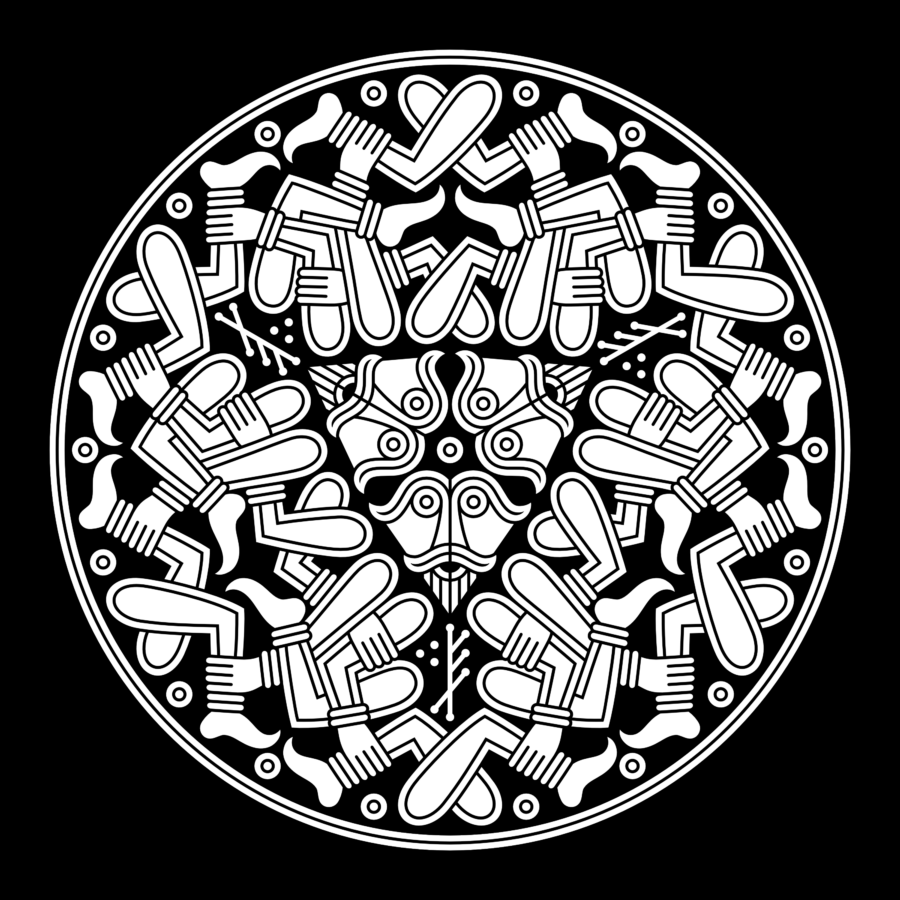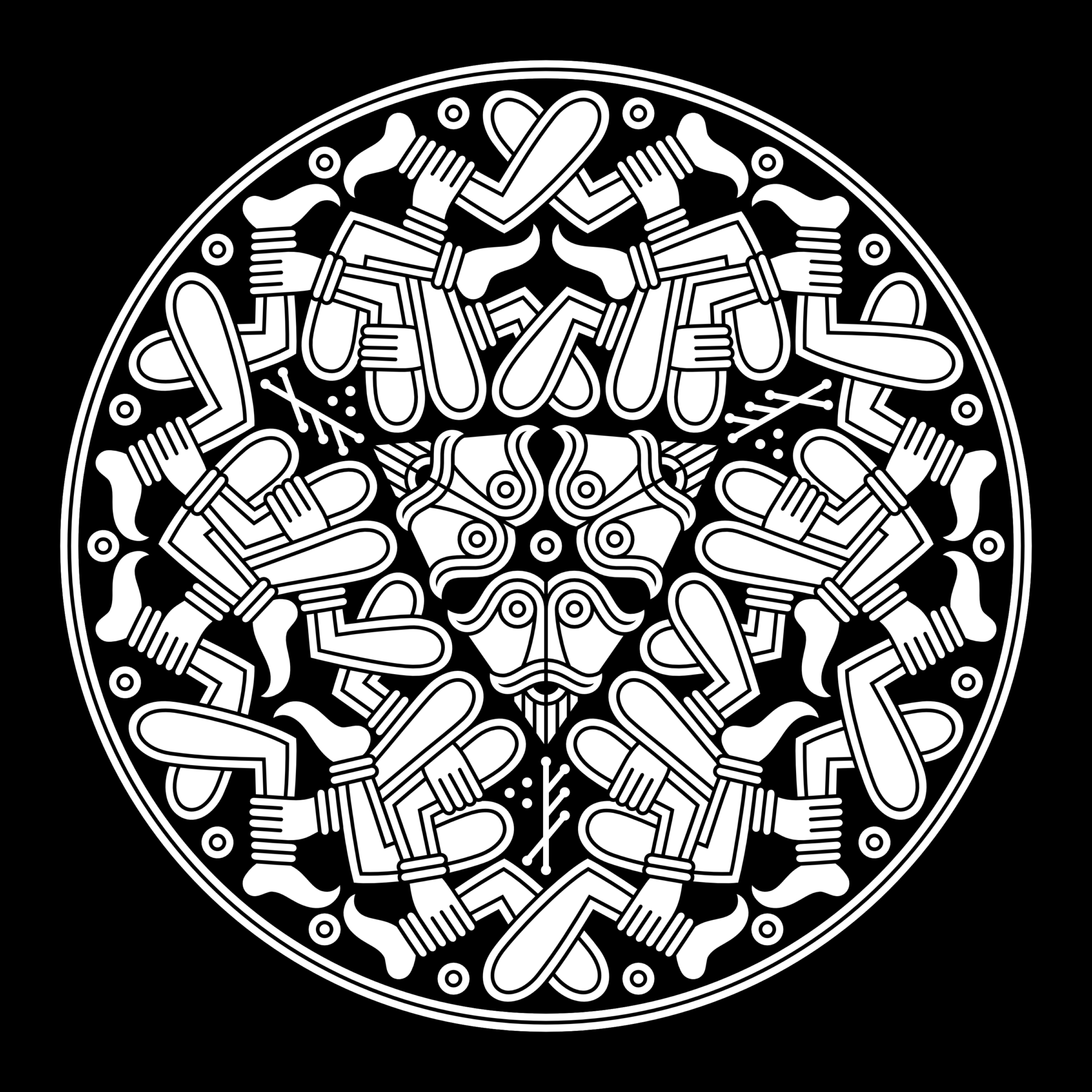
Aun Wheel
March 7, 2023
Today (March 7) marks one of the main holidays of the 2023 Aun Year. The Aun Year celebration is probably the most significant of the heathen traditions.
Rune Hjarnø Rasmussen has initiated the recovery of the octennial Aun celebration as an open call to reimagine this recurring event of reconnection and healing.
The tradition is named after the legendary king, Aun, who sacrificed his kin to prolong his life (read the full story of Aun below);
“The story of Aun is a cautionary tale. He is the best example of the worst imaginable ancestor. Aun’s murder of his sons is part of a general theme in Nordic Animism: violation of kinship resulting in cosmic collapse.”
– Rune Hjarnø Rasmussen
The Aun celebration, on the other hand, is the antidote to the rupture of kinship and connectedness.

Realignment of the Solar and Lunar Cycles
The beginning of the 2023 Aun year is marked by the sun and the moon emerging together from the darkness at the winter solstice, realigning the new solar and lunar year. Thus, resetting the clock and calling on us to mend what has been broken during the past octennial cycle(s) since the last realignment(s).
In the runic calendar year of 2023, the Sundays of the solar cycle are counted by the Fé rune of wealth and abundance, and the lunar cycle is marked by the rune Ár conveying the meaning of a good and plentiful year. Together they comprise an auspicious bind-rune for the 2023 Aun Year, invoking the most fertile conditions for the cyclical healing of the Aun celebration imaginable.
Traditionally the lunar and solar cycles also played an essential role in the timing of the Aun year’s celebratory events:
“Medieval chroniclers report that pre-Christian Scandinavians congregated in large numbers at regional sacred sites every eight years. The Danes would gather at the ancient sanctuary Lejre in Zealand at the Yule moon, in a ritual which, according to the chronicler Thietmar of Merseburg, was supposed to align people with “those who dwell beneath the earth and ensure their forgiveness for any misdeeds”. Swedes would sacrifice in their sacred grove in Uppsala and sing songs that were too “unseemly” for the Christian chronicler Adam of Bremen to commit to parchment.”
– Rune Hjarnø Rasmussen
The Uppsala event was most likely held in connection with the Disthing at the Full Moon closest to the Vernal Equinox. Adam further describes the sacrificial practices held at the temple in Uppsala, where nine males of every living creature are offered up for sacrifice, mirroring the mythical sacrifice of Aun’s nine sons. The sacrificed bodies are all hung in the trees of the sacred grove beside the temple.
A Sacrificial Aun Wheel
I’ve been contemplating how to engage with the Aun year. Listening (and re-listening repeatedly) to Tyson Yunkaporta’s yarn with Rune on the Aun Year inspired this design; a sacrificial wheel (or tree) composed of the detached limbs of nine male bodies woven together in a sort of sacralised funerary tableaux, drawing on both the Aun myth as well as the ancient heathen sacrificial customs at Uppsala.
It’s an unsettling image containing Aun’s depraved sacrifice of his kin and the Uppsala ritual meant to heal the rupture and reconnect. It’s an uneasy call to acknowledge our unhealthy ways of exploitation and to sacrifice elements of our life that derive from society’s abusive aspects.
You’re welcome to use the Aun Design in Your Celebration!
The Aun Wheel design is meant to be shared and used freely to promote and invoke the healing intentions and celebration of the Aun year.
Download hi-res versions of the image for free.
For a little more context on the meaning and inspiration for this image, here’s my paraphrasing of a few core points from Rune and Tyson’s conversation:
The story of Aun is a cautionary tale of a king sacrificing each of his nine sons to extend his life beyond its natural limits. It’s a pertinent tale addressing the parallel pathology of our current time where we, too, are killing our children’s future to uphold our own progressively hollow existence in complete disregard for the integrity of the earth and our peers across the globe — Modernity is murdering the covenant!
The octennial Aun celebration is a call to acknowledge and repair broken relations to restore kinship and connectedness.
Remember!
Magic is unexceptional and mundane.
Magic is always a shared experience.
Magic is spending time with your local landscape.
Magic is silently acknowledging the open wound.
Magic is actively dismantling hierarchies piece by piece.
I highly recommend listening to Rune and Tyson’s conversation and checking out Tyson Yunkaporta’s book on indigenous knowledge systems Sand Talk.
Here follows the story of Aun as recollected by Snorri Sturluson in the Ynglinga Saga.
The Death of Aun
Jorund’s son was called Aun, and he became king of the Swedes after his father. He was wise and eager to make sacrifices, but he was no warrior and stayed home in the country.
At the time when these kings, who are told about here, lived in Uppsala, Denmark was first ruled by Dan the Magnificent; he became very old. Then his son Fróði the Magnificent or Peaceful, and then his sons Halfdan and Fridleif. They were great warriors. Halfdan was the oldest and, in every way, foremost of them. He went with his army to Sweden against king Aun. They fought a few times, and Halfdan was victorious each time, and finally, King Aun fled to Västergötland. He had then been king of Uppsala for 20 years and stayed 20 years in Götaland while King Halfdan was king of Uppsala.
King Halfdan died of illness in Uppsala and was buried in a mound there. After that, King Aun returned to Uppsala; he was then 60 years old. He held a great blot and sacrificed to obtain a long life. King Aun received the answer from Odin that he would live another sixty years.
Aun was king in Uppsala for another 20 years. Then Fridleif’s son Ale the Bold came with his army to Sweden against King Aun. They fought several battles, and Ale was victorious each time; then, King Aun fled for the second time from his kingdom to Västergötland. Ale was king of Uppsala for 20 years before Starkad the Old killed him.
After Ale’s fall, King Aun returned to Uppsala and ruled the kingdom for another 20 years. Then he held a great blot and sacrificed another son. Then Odin told him that he would live as long as he gave Odin one of his sons every ten years and that he should name one of the districts in his country after the number of sons he sacrificed to Odin. When he had sacrificed seven of his sons, he lived for ten years but was so frail that he could not walk and was carried on a chair. Then he sacrificed his eighth son and lived another ten years bedridden. Then he sacrificed his ninth son and lived another ten years drinking from the narrow part of a horn like an infant.
He had one son left, and he now wanted to sacrifice him and give Odin Uppsala and the surrounding districts and call it ‘Tenland’, but the Swedes forbade him to do so, and no sacrifice was made. Then King Aun died and was buried in a mound in Uppsala. It has henceforth been known as Aun-illness when someone dies disease-free of old age.
———
Snorri Sturluson, c. 1225. Ynglinga Saga, Heimskringla.
The English translation is based on the Danish translation by Jesper Lauridsen (2012) and the Swedish translation by Emil Olsson (1919-26), provided by heimskringla.no.
How to Celebrate Aun
There’s no preordained way to celebrate the year of Aun correctly. It is up to you to reimagine the tradition however you see fit (hopefully, I don’t have to point out to you that sacrificing any animals or human beings is NOT the way to do it in 2023!). At nordicanimism.com/aun-2023, Rune has listed a few suggestions for “invoking the power of our traditional Animist knowledge in healing the Aun pattern of violence that characterise our societies.” You could, for example;
Make Aun tokens for your celebrations
Create something under the auspices of Aun. You could, for example, craft an Aun rune out of wood or metal, paint it or bake it. Or you could brew beer, bake a cake or plant a tree.
Reconnect with the land and sacred heathen sites
Create respectful relations with your local landscape or make a pilgrimage to regional sacred sites. It can be as simple as connecting with your surroundings by spending time in nature or your local park.
Celebrate this year of Healing
Make rituals for it, pray for it, dance for it, dialogue about it, celebrate it in your gatherings and festivals, and call for the cyclical healing of the Aun year. Call on the deities you’re usually building relations to, but do it under the auspices of the Aun year, for example, by using the Aun rune.
Give some of Yourself
Sacrifice elements of your life ways that derive from the abusive aspects of society. This could be giving some of yourself, i.e. some of your privilege, for example, by switching to a plant-based diet or by giving your time and expertise and getting involved in a good cause or organisation.
Make an Oath
Make an oath under the rune of Aun to change your ways predicated on destruction. This could directly relate to the previous suggestion of sacrificing some of yourself. Obligate yourself to something that contributes to the healing.
I’d love to know how you celebrate the 2023 Aun year and if you’ve used my Aun design above. So feel free to share!
May you have a Good Year of Aun!
Jonas Lau Markussen
